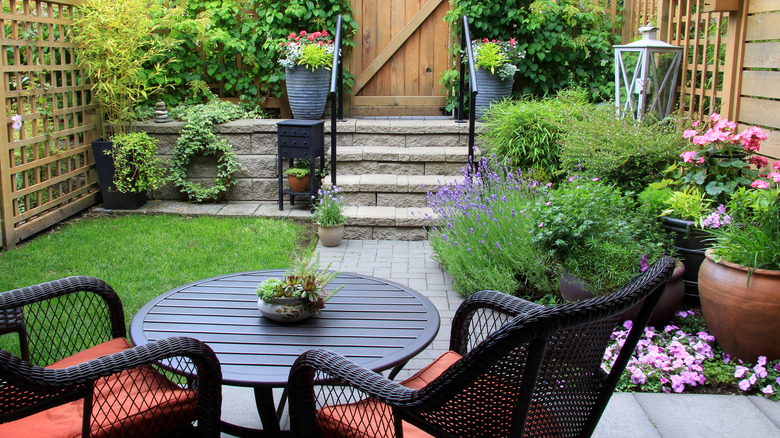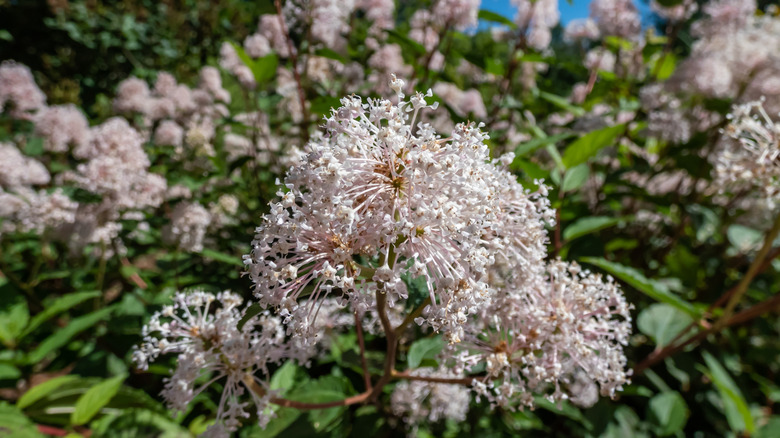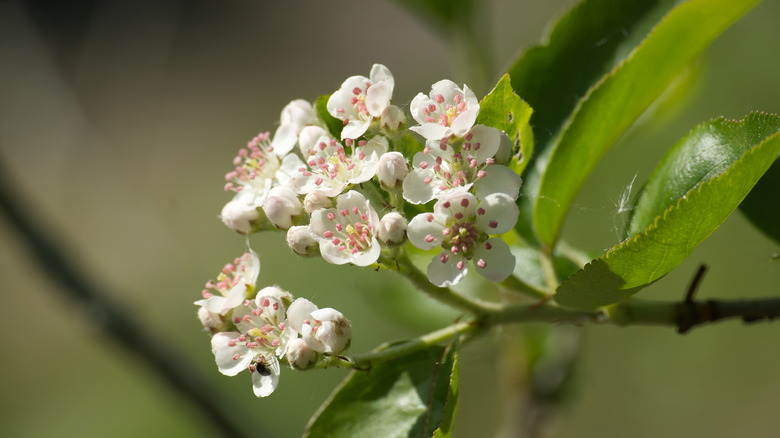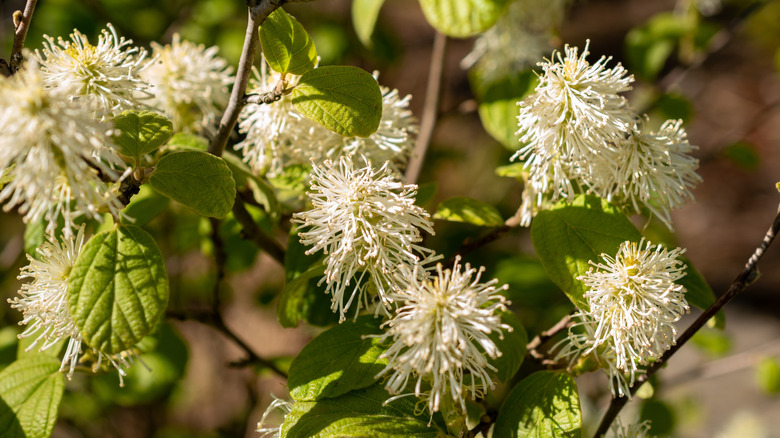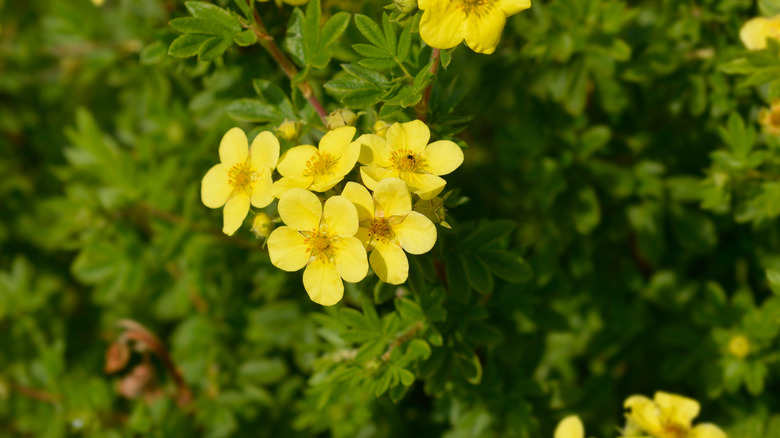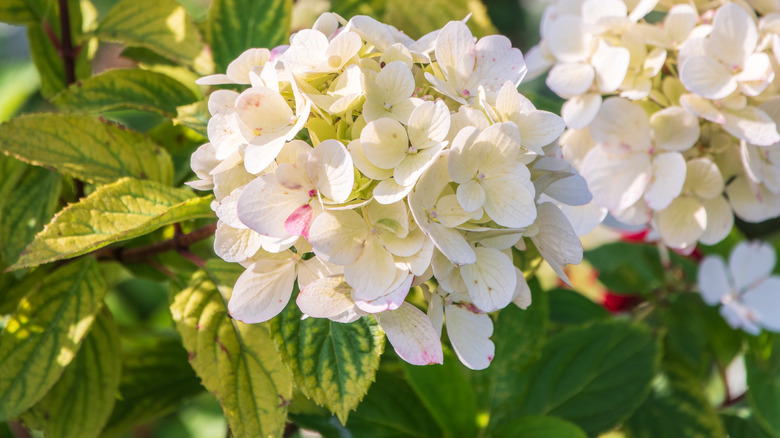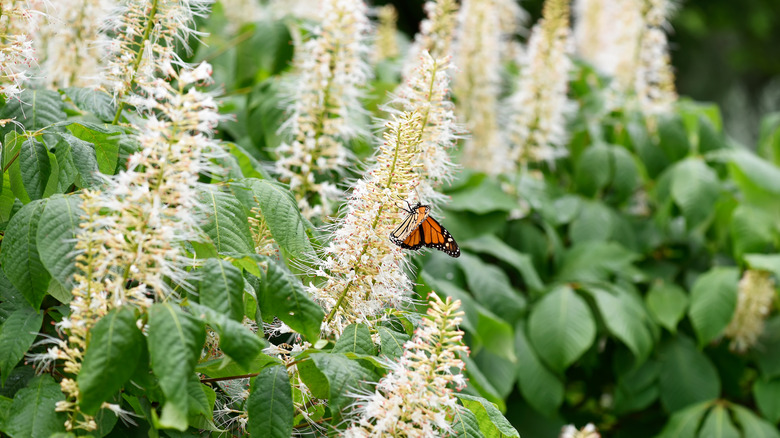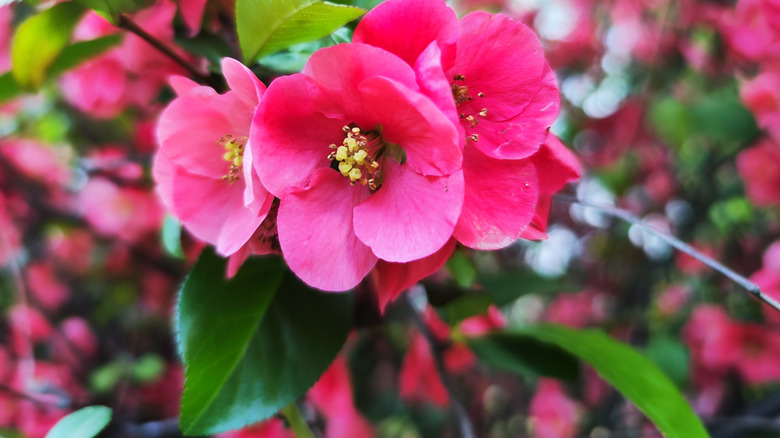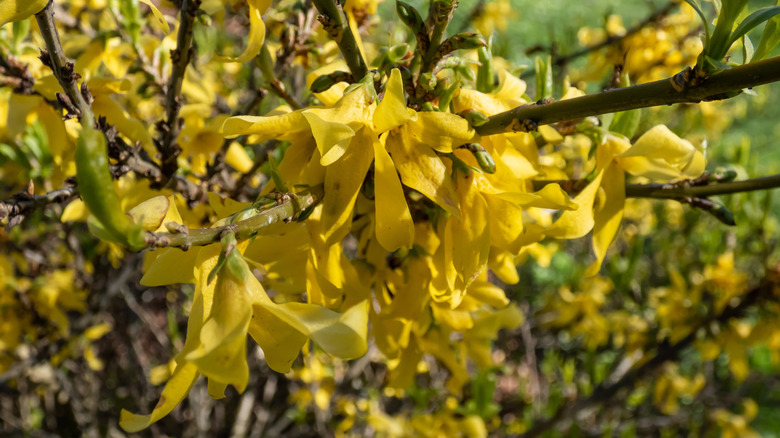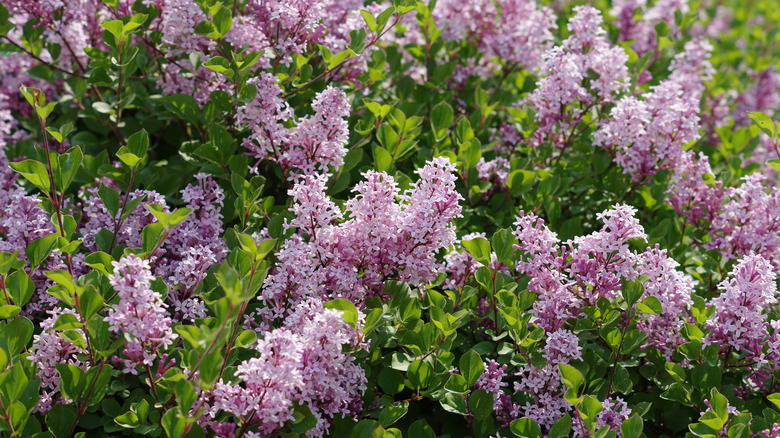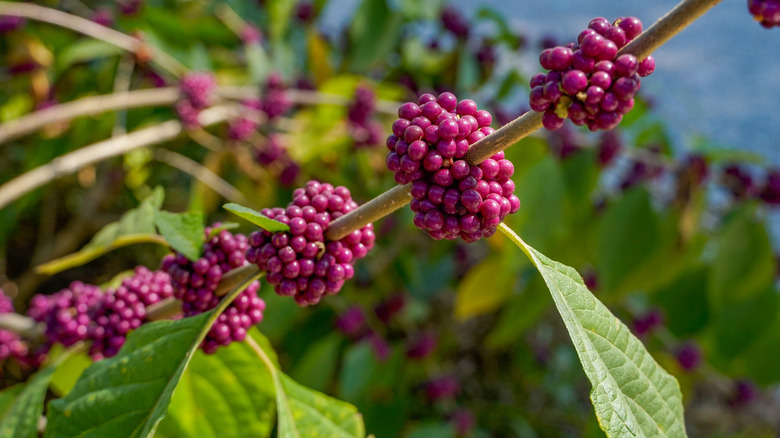The 10 Best Flowering Shrubs To Plant If You Have A Small Yard Or Garden
We may receive a commission on purchases made from links.
According to the National Association of Home Builders (NAHB), nearly two-thirds of new single-family homes are now being built on lots of one-fifth of an acre and under, a significant drop compared to previous decades. While that gives many of us less room to work with, it also offers the chance to create more intimate and intentional outdoor spaces, with the added bonus of less upkeep than larger landscapes. With the right compact flowering shrubs, you can add bursts of color to your garden throughout multiple seasons, attract beautiful pollinators and birds, and, according to a study conducted by the Virginia Cooperative Extension, even help boost your home's value.
If you want to make the most out of a small backyard or garden, determine which shrubs align best with your landscaping goals and match your yard's conditions. Some varieties bloom more profusely when planted in full sun, while others will thrive even in limited light. Certain shrubs are perfect for trickier areas, like erosion-prone slopes or rain gardens. If you want a yard buzzing with pollinators, choose native, nectar-rich flowering shrubs, as they tend to be more beneficial than many exotic cultivars. For the most impact in a small space, look for flowering shrubs that combine multiple standout features, like many of those listed below.
New Jersey tea is a compact food source for birds and pollinators
You may think you need an enormous backyard to create a thriving ecosystem, but in reality, you just need a few small plants that can do it all. New Jersey tea (Ceanothus americanus) is a compact native shrub that may only reach 3 feet tall and 5 feet wide, but significantly helps local wildlife. In early summer, it boasts sweet-smelling, creamy white flowers that are like magnets to bees, butterflies, moths, and predatory wasps. Because the New Jersey tea shrub supports specialist bees and serves as a larval host for butterflies like the mottled duskywing and spring azure, planting one can help combat habitat loss these pollinators can face. This is also a shrub that will help attract more songbirds to your yard with its seeds that ripen in late summer or early fall.
The easy-to-grow New Jersey tea is one of the best shrubs for beginner gardeners. It thrives in USDA hardiness zones 4 to 8 and will happily grow anywhere with full sun to partial shade and well-drained soil. While it prefers sandy loams or rocky soils, this nitrogen-fixing plant can flourish in difficult areas of your garden with dry, poor soil. Watering is key for healthy early growth, but it's incredibly drought-tolerant once established. Although its deep root system makes it nearly impossible to transplant, it's also what makes it perfect for slopes susceptible to erosion. You can also use this shrub for foundation plantings or let it shine as a specimen plant.
Black chokeberry
Plant a few black chokeberries (Aronia melanocarpa) if you want flowering shrubs that will bring drama to your yard throughout multiple seasons. This native beauty bears white or pink blooms in spring, followed by attractive blackish-purple berries in the summer. By fall, its green foliage turns to a brilliant red-purple, bringing a final burst of color before its leaves drop in winter. Growing 3 to 8 feet tall and 2 to 6 feet wide, it's a great option for smaller yards or gardens, and there are several dwarf cultivars, like 'Iroquois Beauty', that are even more compact. Wildlife loves it too; its nectar-rich flowers are popular among pollinators, it's a host for coral hairstreak butterflies and large lace-border moths, and its showy berries attract several songbirds. If you're able to get to the chokeberries before the birds do, you can use the tart fruits to make jams and jellies.
Black chokeberry is hardy in zones 3 to 8, standing up to both harsh winters and hot summers with ease. This adaptable shrub grows well in full sun or partial shade and tolerates a wide range of soils, including wet, boggy conditions, making it perfect for rain gardens or pond edges. However, it's also impressively drought-tolerant once established. Black chokeberries require little pruning aside from removing dead or damaged branches and controlling the spread of its suckers as needed. Alternatively, you can leave them be if you want a naturalized look.
Dwarf fothergilla
Dwarf fothergilla (Fothergilla gardenii) is the perfect little shrub you can tuck nearly anywhere in your yard, especially if you're aiming for a cottage or native garden. It's a slow grower that can reach 3 to 6 feet tall and wide, though it typically matures at 2 to 3 feet. This is another native option that delivers multi-season beauty, starting with its white, honey-scented bottlebrush flowers in spring. You'll get lots of bird and pollinator visits, as butterflies, bees, and hummingbirds all love its nectar, and other birds appreciate its dense cover. In fall, its blue-green foliage turns to brilliant shades of yellow, orange, and red for a stunning autumn landscape.
Although dwarf fothergilla is typically hardy in zones 5 to 8, there are a few cultivars, like 'Windy City', that can grow in zone 4. Give it a spot with full sun to encourage the best blooms and fall color. Once established, it's drought-tolerant and can handle wet soils, but it prefers moist, rich, well-drained sandy loams. If you have alkaline soil, make sure to amend it with something like elemental garden sulfur (the Earth Science Fast Acting Sulfur could be a good choice if you want quick results) to lower the pH. Alternatively, organic mulch can help make it more acidic over time while helping to maintain moisture. This shrub works beautifully as a specimen plant, but it's equally striking when planted in groups or used to create a small hedge. With its compact growth and tidy, rounded form, you can also use it for foundation plantings and borders.
Shrubby cinquefoil
If you're looking for an easy-growing, flowering shrub that won't overwhelm a small yard, shrubby cinquefoil (Dasiphora fruticosa) is a perfect choice. It maintains a compact, rounded shape, usually reaching just 3 to 4 feet in both height and spread. A favorite for pollinator gardens, shrubby cinquefoil is one of the flowering plants that will bloom all summer long, often continuing from early summer into early fall. Its cheerful yellow blooms support pollinators like butterflies, bees, and even several specialized native species that rely on this plant for food and habitat. You can also choose from several cultivars with flowers that come in shades of pink, white, or orange for a different splash of color.
Shrubby cinquefoil flowers best when planted in a sunny area of your yard, though it can tolerate partial shade. It grows well in several soil textures, including clay, as long as it's well-drained. Hardy in zones 2 to 7, it's right at home in northern regions with mild summers. High heat can be stressful for this shrub, and humidity can make it more prone to fungal diseases like powdery mildew, so it's best to skip this plant if you live in hot and humid southern states. As it ages, regularly pruning each winter can help keep its tidy, rounded appearance. Once established, it's drought-tolerant and makes a great shrub for erosion-prone areas of your yard. You can also easily use this exceptional bloomer for mixed shrub borders or foundation plantings.
Smooth hydrangea
Although smooth hydrangeas (Hydrangea arborescens) feature large, showy blooms, they're pretty compact as a whole. These fast-growing shrubs are about 3 to 5 feet tall and wide, though they tend to grow outward more than upward. Depending on the cultivar, rounded clusters of creamy white or pink flowers appear in early summer, sometimes lingering through early fall. Smooth hydrangea is a host plant for the hydrangea sphinx moth, and the profusion of nectar-rich blooms invites butterflies and other pollinators to your garden. As their seeds ripen in autumn, songbirds will stop by to snack on them.
Smooth hydrangeas are among the hardiest varieties, thriving in USDA zones 3 to 9 and tolerating colder climates better than most other types. Unlike many hydrangeas, their bloom color stays the same regardless of soil pH, but they still prefer neutral to acidic soil conditions. While they can tolerate full sun if the soil stays moist, they thrive in partial shade, so you can easily add them to shady areas of your yard. This variety blooms on new wood, so you can cut it back in late winter to encourage fresh stem growth. Although most hydrangeas are native to Asia, smooth hydrangeas are one of the five native to the United States, making them perfect for native landscapes and pollinator-friendly gardens. Whether you grow one as a standalone feature or several in mass or mixed borders, they're sure to make any garden pop.
Summersweet 'Hummingbird'
Growing just 2 to 4 feet tall with a slightly wider spread, summersweet 'Hummingbird' (Clethra alnifolia 'Hummingbird') is a stunning cultivar of the sweet pepperbush, but more compact. Plus, it comes with all of the same benefits as its parent species, though it blooms more profusely. True to its name, hummingbirds, butterflies, bees, and other pollinators are drawn to its large, fragrant, creamy white flower spikes that last for 4 to 6 weeks from middle to late summer. As the green foliage fades to shades of gold or yellow in fall, brown seed capsules mature and provide nutrition for birds, sometimes even in winter months when food is harder for them to come by.
If you're growing a flourishing shade garden, summersweet 'Hummingbird' can work well to brighten up the darker corners. While it prefers full sun to partial shade, it's surprisingly tolerant of heavily shaded areas as well. Hardy in zones 3 to 9, there isn't much this tough shrub can't handle, tolerating clay or compacted soil, salty air, wet sites, and wind. It also stabilizes the soil, making it a great option for areas prone to erosion. That said, it particularly likes acidic, sandy soils, as long as you never let them dry out. As a moisture-lover, it thrives in rain gardens, near natural water sources, and in low-lying spots where other plants may struggle. Make sure to plant it in an area where you can enjoy its sweet perfume and watch the pollinators buzz around.
Japanese quince 'Pink Lady'
There's nothing quite like the rich pink blooms that Japanese quince 'Pink Lady' (Chaenomeles × superba 'Pink Lady') has to offer. 'Pink Lady' may only grow 3 to 5 feet tall and wide, but it puts on a floral show that rivals larger flowering shrubs. Its numerous clusters of colorful flowers will bloom in your garden in early spring and last for several weeks, and bees can't get enough of their nectar. Birds love the apple-scented yellowish pomes that appear in fall. Although the fruits are technically edible, they tend to be too tart to enjoy when plucked straight from the branch, though they work well for jams or jellies. That said, their seeds contain toxins, so make sure to remove them before eating.
Once settled into its new environment, 'Pink Lady' is an incredibly low-maintenance plant. While you can add this shrub to a partially shaded spot, the best flowering occurs in full sun. As long as it's well-drained, it'll grow in nearly any soil type, including dry or clay soil. It's important to note that although some quince varieties can handle slightly colder weather, 'Pink Lady' is best suited for zones 5 to 8. There aren't many areas of your garden where 'Pink Lady' won't shine, whether planted in mass, added to a mixed border, or grown alone to show off as a focal point in your yard. Alternatively, you can train its thick, arching stems to grow up a wall or trellis.
'Gold Tide' forsythia
'Gold Tide' forsythia offers the sunny spring color of classic forsythia, but in a pint-sized, ground-hugging form. It stays much smaller than most shrubs, forming a low mound that's only 1 to 2 feet tall with up to a 4-foot spread. This cultivar is exceptionally showy, with masses of vibrant yellow, bell-shaped flowers emerging on bare branches in very early spring. With so many nectar- and pollen-rich blooms, pollinators like butterflies and bees will eagerly stop by for an early-season meal. The ovate, medium green leaves arrive afterward, keeping their color throughout the summer.
This easy-going beauty can grow in poor soil, but thrives when planted in loose, well-drained soil. It's another shrub that can handle part shade, but rewards you with its best flower production when planted in an area that receives at least 6 hours of direct light. Once established, 'Gold Tide' is moderately drought-tolerant, but prefers regular moisture. Although technically hardy in zones 5 to 8, it may not bloom as well in zones 5 and below if a late winter freeze hits, especially if temperatures fall below -5 degrees Fahrenheit. It can get a little gangly without regular pruning, so remove any overgrown stems once the blooms fade but before new buds emerge. You can use this small forsythia in borders, foundation plantings, or even as a groundcover for bare patches. If you enjoy having homegrown bouquets, it also offers perfect flowers for a cut flower garden.
Dwarf Korean lilac
If you want to fill your yard with the sweet scent of lilac blooms, but don't have room for a traditional variety, dwarf Korean lilac (Syringa meyeri 'Palibin') may offer the perfect solution. Like the classic garden favorite, this cultivar delivers clusters of pale purple flowers that attract bees, butterflies, and hummingbirds, but in a smaller package. It tops out at about 4 to 5 feet tall, with a slightly wider spread of 5 to 7 feet, though regular light pruning will help it stay more compact.
Grow dwarf Korean lilac in rich, moist, well-drained soil in full sun for the best blooms. Although it looks like a delicate beauty, this cold-hardy shrub thrives in zones 3 to 7, so it'll happily grow in your yard even if you have frosty winters. To encourage increased blooming the following year, snip the entire cluster off once the flowers fade and before it seeds. You can also prune the entire shrub at this time, though be careful not to remove more than 30% of the top. While this no doubt works as a specimen plant, there are several ways you can use dwarf Korean lilacs in your garden. Create showy shrub borders, use them for informal hedges in cottage-style gardens, or pair them with companions in mass plantings. Thanks to its intoxicating fragrance and large blooms, it also makes a beautiful addition to cut flower gardens.
American beautyberry
Few shrubs can check all the boxes that the American beautyberry (Callicarpa americana) does. Despite its long, arching stems, it typically grows to a manageable 3 to 5 feet tall and wide, making it an easy fit for small yards. Although its delicate pink, lavender, or pale blue blooms are attractive in their own right, it's the vibrant clusters of glossy, bright purple berries that will really make your garden stand out. The pretty flower clusters will add some color to your landscape in late spring to early summer, while providing valuable nectar to pollinators, particularly bees. Its showy fruits appear in late summer to early fall, often encircling the stems through winter. As songbirds like finches, thrashers, and robins search for food in the chilly season, beautyberries will provide a much-needed snack. The green foliage fades to a pale yellow in autumn, before dropping its leaves as winter approaches.
Hardy in zones 6 to 10, American beautyberry is remarkably easy to grow, thriving in full sun to partial shade. It adapts easily to nearly any well-draining soil type, from clay to sand, and can withstand wet or dry conditions. You can leave it untouched for an informal look, or prune it in late winter to encourage denser growth. Because of its adaptability, you can place it almost anywhere in your yard where you want a pop of color throughout the seasons. It's a top choice for wildlife gardens, cottage-style landscapes, naturalized borders, and even rain gardens.
